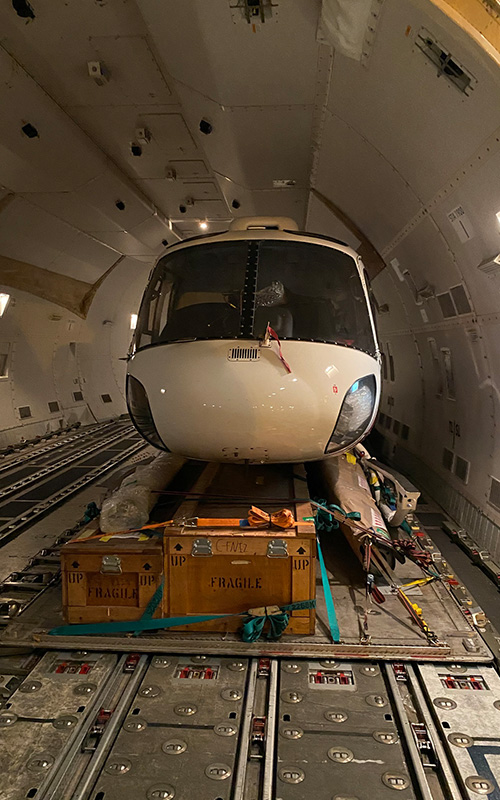Helicopters are fragile, complex and extremely expensive pieces of machinery that require special care when shipping. Take a new Bell 412. This is a popular mid-sized machine favoured by the military, law enforcement, coastguards and commercial operators, such as in the oil industry, the world over. A new one off the production line, depending on the options it’s fitted with, costs around US$11m. That showroom price means that special handling isn’t just an attribute of the machine itself; it’s also essential for its safe transport.
Montreal office Manager Michael Fan at freight forwarder Dimerco has become quite the expert in shipping helicopters in recent years, having handled 50 to date. Montreal may seem a strange origin, but Quebec’s biggest city is something of an aerospace hub. In fact, in market terms, it is third only to Seattle and Toulouse, the homes of Boeing and Airbus respectively. In the area, there are multiple firms making components for aerospace supply chains, and some finished products, including helicopters.
While these rotorcraft may be nimble in the air, they are slightly awkward to move on the ground when not under their own power. Take, again, the Bell 412, the largest helicopter Fan has handled for a shipping client. It has a main rotor blade diameter of 14 metres, and in full passenger configuration, it can hold up to 13 people. Clearly, something has to give if you want to fit a chopper like that into the main deck of even a Boeing 747 freighter.
‘Usually, the helicopter is disassembled by the manufacturer before transport,’ Fan explains. ‘The tail boom and rotor blades are packed separately to the main fuselage.’

That deals with most of the protruding parts of the airframe, which are securely boxed up and tucked away, but there is still an oversized element to these shipments. ‘Depending on the model, a helicopter shipment could occupy two, four, five or six positions,’ says Andrew Poon, Cathay Pacific Cargo Account Manager in the Toronto office. ‘For a smaller model, you can fit all the parts and the fuselage on a single PGA [20 foot/six metre] pallet occupying two spaces. Larger models may require two PGA pallets for the fuselage as a base but overhang up to six positions.’
The main fuselage is arguably the biggest, most exposed and most fragile part of the shipment. Even covered to protect it from scratches, it is recognisable as a helicopter component. ‘It’s also the most prone to damage,’ says Fan.
The secret to successful shipping comes from not just booking the required space but also in planning each stage of the process so that all partners, from ground handling agents to airlines to trucking companies, are working in sync to an agreed plan, which will differ according to each helicopter make and model. Some elements of the job remain consistent. The fuselage will usually be covered in layers of shrink wrap for protection, and great care will be needed to lash and secure these irregular shaped parts to pallets and the aircraft. ‘Solid blocking and bracing of the cargo on the airline pallet are crucial,’ says the Dimerco manager.


As an airline partner, Cathay Pacific Cargo plays its part, too, as Poon explains. This partly comes from its Expert LIFT solution, a customised service for irregular shipments and outsized cargo. On top of having access to appropriate loading equipment and the option of nose-loading on its fleet of 20 Boeing 747 freighters, not to mention years of expertise in transporting special shipments, Cathay Pacific Cargo takes further steps that are unique to helicopter shipments. ‘We always send out a pre-alert message to all handling parties to be extra vigilant because these are fragile, high-value shipments,’ says Poon. ‘We also take pictures of the helicopter during the staging process in the warehouse and during and after loading and send them to the forwarder and shipper so that they are kept in the loop.’

Cathay Pacific Cargo recently transported a helicopter from Canada to Zhengzhou in a shipment that helped prove the effectiveness of the latter airport’s new North Cargo Terminal, from which Cathay Pacific Cargo operated its first freighter service in August. It was a good trial of the new facility and proved the greater operational efficiency of parking bays close to the terminal and the ability to cope with irregular shipments.
It’s another reason why Dimerco (Aerospace Logistics Services — Dimerco), an aerospace logistics expert, works with Cathay Pacific Cargo as a trusted partner to plan and implement these specialised air cargo shipments. According to Fan, the secret to shipment success is working with ‘reliable and experienced experts in aerospace logistics’. Mission accomplished.









